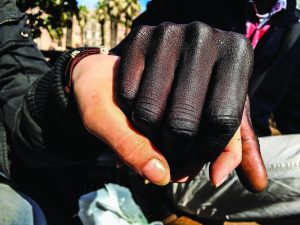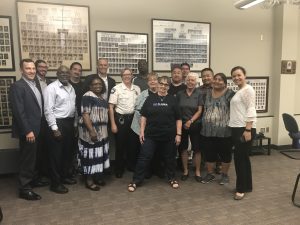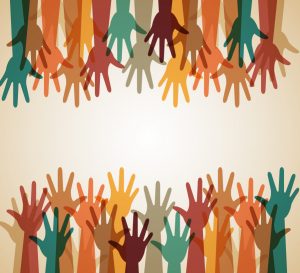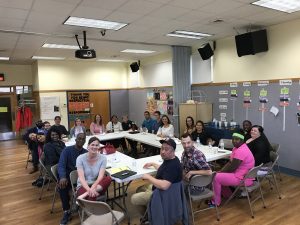Building relationships between the police and “the community” is deeply complicated. In truth, there are always multiple communities that police need to build relationships with, especially in urban areas. Cities—and even single policing districts—are often segregated by race, ethnicity, income, and even age. Those communities often have distinctly different perceptions of and relationships with the police.1 Furthermore, members of these communities can have conflicts with each other.2
The South District of the Madison Police Department (MPD), Wisconsin, is one such place.3 The most diverse district in Madison, it is composed of African American, Latinx, Hmong, and white communities.4 White community members had treated police as service providers and regularly participated in feedback efforts, but members of the other communities in the district had not. African Americans often perceived police as antagonistic to the community. Latinx community members worried about having their immigration status questioned by police, an anxiety complicated by the negative perceptions of police some may have brought with them from their countries of origin. Hmong elders’ perceptions of police were complicated by historical issues with the police, as well as by language differences.
Officers of the South District, led by Captain John Patterson, wanted to build better relationships with all three communities. Beginning in 2017 with a small grant from the Office of Community-Policing Services (COPS Office) Community Policing Development program, the district launched an initiative to directly engage with members of each community. The initial goal was to receive feedback and advice from community members and provide information to them. Over the course of the program, however, all involved began to realize that they were also building relationships across the communities.
The innovative model developed through this project has five essential parts:
1. Partnering with community-led organizations
2. Engaging with community-based bridge builders from the organizations
3. Gathering information and recruiting participants through bridge builders
4. Holding direct community discussions
5. Turning information into action
1. Partnering with Community-Led Organizations
The MPD South District leadership had already developed some relationships with three community-led organizations in the district: the Nehemiah Center for Urban Leadership Development, an African American-led organization; Centro Hispano, a Latinx-led organization; and the Bayview Foundation, a Hmong-serving organization with multiracial leadership. The MPD leadership contacted leaders from each of these organizations to help build a multiracial police advisory group, and these leaders collaborated to design the advisory group process.
Each organization identified a community leader who lived in the area and was a member of their respective racial community. MPD then contracted with each organization, providing grant funds for each identified community leader to act as a bridge builder who could develop relationships both with other community members and with MPD.
2. Engaging with Community-Based Bridge Builders
 The role of each bridge builder was to gather thoughts and concerns about policing from South District community members. Bridge builders, MPD leadership, and a university-based evaluation team jointly developed a short interview guide for bridge builders to use in soliciting community input. Bridge builders then brought what they learned to monthly meetings with the MPD South District captain, lieutenants, and occasionally others. The bridge builders were paid for their work, which put them on equal footing with the MPD representatives and evaluation team who all participated as part of their paid professional activities.
The role of each bridge builder was to gather thoughts and concerns about policing from South District community members. Bridge builders, MPD leadership, and a university-based evaluation team jointly developed a short interview guide for bridge builders to use in soliciting community input. Bridge builders then brought what they learned to monthly meetings with the MPD South District captain, lieutenants, and occasionally others. The bridge builders were paid for their work, which put them on equal footing with the MPD representatives and evaluation team who all participated as part of their paid professional activities.
Both MPD leadership and the bridge builders had anticipated that these meetings would involve a widening circle of diverse residents and focus more on police procedure and practices, with bridge builders sharing concerns from the community and police officers providing explanations of and seeking advice on particular decisions. However, the group discovered that the work of building trust and cross-cultural understanding among the participants took more effort and time than expected. The bridge builders reported that recruiting community members to attend meetings and events is always difficult due to a lack of time, work conflicts, family responsibilities, and transportation limitations, but recruiting for this project was particularly challenging due to the community members’ apprehension about engaging with the police.
The monthly meetings then focused on building trust between the police and the bridge builders, who brought concerns from residents who were too uncomfortable to attend the meetings but were willing to share their thoughts with the bridge builders. Perhaps as a consequence of the relatively small and stable group (six people including the three bridge builders, the MPD captain, and two lieutenants), the participants found that they gradually achieved a level of trust and an ability to share experiences honestly in the monthly meetings. There were frank discussions of procedure and policy—e.g., the captain asking for feedback on a decision to increase patrols following a shooting, a bridge builder sharing a video of a person being shot and asking why the police made the choice to use deadly force , another bridge builder pushing for an explanation of why police ask individuals for identification—but participants primarily focused on the bigger process of building trust and relationships. The tension between these two goals of building trust and creating new structures for advice, information, and accountability was a constant at every stage of this project.
“New relationships have been built between police officers, community organizations, and community members.”

The group’s unity and pride also grew through an overnight field trip to observe a community-police advisory board in another city. On the drive to and from the city, and in the more social settings on the trip, community members were able to ask questions about police practices and share more about their personal backgrounds and cultures. Additionally, as the Madison group compared their diversity to the nearly all-white composition of the advisory board they observed, the participants reaffirmed their commitment to the more difficult, slower work that they were doing because of the additional voices it brought to the conversation. One officer reported with pride that his counterpart in the other city approached him and asked how the group had become so diverse so quickly, seeking advice to increase their own diversity. One of the bridge builders reflected that he had expected to learn something from the other advisory group, but instead became the teacher and explained an alternative model for a community-police advisory board.
These experiences reaffirmed the importance of the model employed in Madison that enabled community-based bridge builders to be fully embedded in this project, acting on an equal footing with the officers.
3. Gathering Information and Recruiting Participants through Community-Based Bridge Builders
Much of the honest sharing that occurred in the monthly meetings was based on a combination of surveys and interviews that bridge builders were conducting with community members. The bridge builders conducted a total of about 90 interviews and surveys. Bridge builders focused on gathering feedback from members of their own communities, enabling them to gather information that MPD’s more traditional survey method, which attracted responses from mostly white middle-class residents, did not usually capture. Each of the three bridge builders approached the interviews in slightly different ways that best fit their communities.
The bridge builder in the African American community used the interviews to intentionally expand his reach, mixing interviews with people he regularly interacted with at Nehemiah and interviews with members of the African American community outside the scope of his usual work. He consciously focused on lower-income African American residents, having observed that middle-class individuals have more opportunities to share their thoughts with the police.

The bridge builder in the Latinx community engaged a group of women that the organization was cultivating as lay leaders (known as “Promotoras”) to help conduct surveys. She and the Promotoras would ask those who came to Centro Hispano for other programs or services if they were willing to fill out the interview as a paper survey, thus getting input from a sample of people that they served. The bridge builder reported that this approach was intended in part to broaden the respondents beyond just people she knew personally and in part to show those coming to Centro that the organization worked with and trusted the police. She was surprised at how positive many of the surveys were (and how little people brought up concerns about immigration enforcement), but she found it was still difficult to get individuals to participate in the survey.
The bridge builder in the Hmong community recognized a division between the experiences and perspectives of Hmong elders and younger members of the community. To capture this dynamic, he intentionally conducted one set of interviews with older residents about their experiences (focusing on stories of immigration, language barriers, and a general respect and trust for the police) and another set of interviews with younger community members (focusing on social media, experience in schools, and distrust of the police). These findings were particularly important because these two segments of the community were very difficult to engage in broader discussions with the police.
The bridge builders’ reports from their interviews and surveys, while not obtained from a scientific sample of people, still show some important themes. One theme is that specific interactions with police officers (both positive and negative) colored some people’s broader feelings toward the police , while for others, deep-seated feelings of respect or mistrust outlasted particular experiences to the contrary. Another theme is that some people distinguish between actually trusting police officers compared to merely not fearing or disliking them. Third, and consistent with people’s unwillingness to attend the monthly meetings, very few people expressed any willingness to getting further involved with the police department.
These data framed the discussions at the monthly meetings, with bridge builders bringing concerns expressed through the surveys and interviews to the police officers for a response. The data were also used to develop the series of questions discussed in small groups at the final Madison Speaks event.
Though the bridge builders could not easily bring other community members to the monthly meetings, this actually had some advantages. The intimacy of the smaller group allowed for more honest sharing, and the trust that resulted allowed the group to carry out two larger community events.
4. Holding Direct Community Discussions

The six-member group planned two larger community gatherings to receive in-person feedback. The first was a potluck at the Bayview Foundation community center with a large-group open-format question-and-answer session. It was well-attended, with 20–25 participants from all three communities. MPD representatives were pleased with the turnout but found the open format to be typical of past meetings they had. From the MPD perspective, this format lent itself to a conversation dominated by only a few voices with a particular perspective, making it harder to engage with people who might experience barriers to participation, be more tentative by nature, or be uncertain in their opinion. One bridge builder expressed a similar frustration about this initial gathering, saying that they felt like the conversation was dancing around the issues and not able to really dig into the community’s concerns.
The group then designed the second gathering by adapting the Orlando Speaks model, which emphasizes small group discussions.5 The event was held in the evening at Fountain of Life Church, pastored by Reverend Dr. Alexander Gee, the founder of the Nehemiah Center for Urban Leadership Development. This event had an even larger attendance, with 60–70 participants from all three communities, along with MPD officers. All of the officers were in plainclothes and intentionally did not park marked vehicles at the church. The event was organized around a meal catered by chefs representing all three communities.6 It included a brief presentation from the three bridge builders about the project’s work up to that point, followed by structured small-group discussions. The hope was that each small group would be diverse, but, because of translation needs and the tendency of people to group with those they knew, the small groups each mostly represented one racial or ethnic community. Each small group included at least one MPD officer. The participants were asked to reflect on their experiences with the police, why they (or others in their community) may or may not trust the police and why they may or may not be afraid of the police. Then participants were asked to share what they thought was going well in terms of police presence in their community, what could be improved, and what concrete steps either the community or the police could take toward making improvements.
5. Turning Information into Action
As discussed above, this project had the dual goals of gathering feedback to inform police practice and strengthening relationships between the district’s police and the Hmong, African American, and Latinx communities. The first step was to identify issues, and two issues in particular generated significant discussion and commitments to action. One issue was concern over people being asked for identification by the police and confusion over community members’ rights in regard to such requests. MPD began planning strategies to distribute information on the issue to the community and to address these concerns in officer training. The second issue was people feeling targeted or profiled by police, and there were discussions around potential police training for this issue as well.
“the small-group format leaves room for variation across groups with some small groups digging into issues more than others.”
Full implementations of these changes are still in process, as of this writing, due to staffing changes in the South District station. The passing of one lieutenant and the promotion of the captain and other lieutenant out of the district made it difficult to fully implement the suggested changes. However, the police officers and bridge builders reported that they felt the project was on the right track. They believed that, if these conversations continued, they would be able to reach more people and have a broader impact, and they hope to still see future successes.
Nonetheless, there were several moments of success for the relationship-building aspect of this project:
-
-
-
- After the three bridge builders spoke at a training for police officers, a new officer developed a relationship with Centro Hispano and came in to lead art projects with children in the community.
- One bridge builder relayed a story of a participant who had passed a police officer in her car. Her daughter warned her that the police were coming, and the mother responded, “It’s OK, the police are our friends now.”
- Another bridge builder reported a conversation with a community member who said that a recent interaction with a police officer had gone better than expected because it was an officer the person recognized from a community event.
- Each bridge builder was invited to contribute their personal stories for a mural painted on the precinct’s community room wall. The bridge builders shared how meaningful it was to them and to their communities to see their stories represented in the precinct.
- Two of the bridge builders expanded their paid employment partly because of their involvement in the program.
- The bridge builders also built relationships with each other, learning more about each other’s life experiences, communities, and perceptions of police. Each of the three community organizations provided space for either a monthly meeting or a community event. Even at the final large community event, there was some mingling across communities.
-
-
These outcomes show how the effects of this project should outlast the duration of the grant. New relationships have been built between police officers, community organizations, and community members. There is a material symbol of the connection between the community and the police painted on the community room wall of the precinct. There are signs that community participants in the project have changed the way they think about their relationship with the police, and police leadership has a new appreciation for just how much intense work is required to build community trust.
What Was Learned
There are several key takeaways from the Madison project.7 The most important is what was learned about the bridge builder as a role that can facilitate honest and fruitful conversations both within the community and with the police. MPD leadership stressed the importance of developing bridge builders as the backbone of community-police engagement. It is important to note that the bridge builders in this program were paid through a subgrant to the mediating community organizations, not directly by MPD, insulating them from the appearance of being part of MPD. MPD’s financial relationship was with the three partnering community organizations. In addition, it was important that the bridge builders lived in the community and thus had inside knowledge of the concerns of its members. Because of this, they brought invaluable perspectives to the project and were able to serve as a more direct communications link between the police department and those members of the community whose voices often go unheard.
For the police, it was also important to have these bridge builders demonstrating to the community that it was possible to partner with law enforcement, which was a critical part of expanding the reach of the program and building trust among a broader range of community members. The bridge builders also believed they were able to access perspectives that police officers could not and engage new people in discussion about policing in Madison.
The two larger community events also provided important lessons. MPD officers and the bridge builders emphasized the need to be intentional about the agenda and format of the larger community discussions. Participants found the unstructured format of the first potluck to be less productive than the structured smaller group format of the second event. The bridge builders didn’t feel comfortable pressing officers on answers to questions in the large group and didn’t want to create conflict in front of others who were just learning to trust the police. In the small-group event, the conversations could be more focused and better show police response to concerns. However, the small-group format leaves room for variation across groups with some small groups digging into issues more than others.
In both settings, however, participants felt the difficulty and importance of having these conversations in multicultural settings. One bridge builder felt the pain of recognizing that the fear of violence and discrimination from police officers was more significant in their community than in others. This bridge builder noted how members of other communities voiced support for the police as a contrast to the criticism coming from members of the bridge builder’s community.
Food also played an important part at both community discussions. Along with access to childcare and transportation, food encouraged and enabled lower-income individuals to attend. It also helped create a more relaxed atmosphere, allowing more casual and open conversation. Finally, intentionally ordering food from African American, Latinx, and Hmong institutions within the community showed that the police supported and respected the communities’ cultures.
It is important to understand that such a program cannot be executed effectively without adequate administrative support. The grant itself was too small to pay for such support, and there was a lack of administrative resources and staff at the MPD, sometimes hindering the progress of the project. Police leadership were responsible for the logistics of scheduling, planning events, and designing and distributing promotional material, while simultaneously managing the day-to-day operations of the district. At the end of the project, MPD leadership reflected that finding a more efficient way to delegate or share administrative duties may have been helpful.
 Additionally, programs such as this occur in a broader context and that context could produce unintended side effects. One such possible side effect, noted at an unrelated Madison community gathering, was that, as relations improved between MPD and the Latinx community, the trust also spread to other law enforcement agencies. However, due to this ripple effect, actions by other agencies could then negatively impact the newly established trust in MPD (e.g., recent federal immigration enforcement in and around Madison).
Additionally, programs such as this occur in a broader context and that context could produce unintended side effects. One such possible side effect, noted at an unrelated Madison community gathering, was that, as relations improved between MPD and the Latinx community, the trust also spread to other law enforcement agencies. However, due to this ripple effect, actions by other agencies could then negatively impact the newly established trust in MPD (e.g., recent federal immigration enforcement in and around Madison).
Finally, this project provided two unintended but also important outcomes. First, it provided an important leadership development opportunity for the bridge builders. Two of the three bridge builders had previously served in volunteer positions with their respective organizations, and this project enabled them to transition into full-time positions that will continue after the grant’s conclusion. In exit interviews, several of the bridge builders discussed using their position in the MPD project to learn more about their own communities, engage with new types of community members, and deepen their work within their organizations. They also discussed learning from Captain Patterson’s leadership and organizational style, appreciating the way he organized and ran meetings, set agendas, and delegated tasks.
Second, the project promoted better understanding between members of Madison’s African American, Latinx, and Hmong communities. While there might not be the level of interracial conflict in Madison that exists in some other places, there is still a separation between the communities. The three bridge builders, in discussing the possibility of continuing the program, emphasized that it was just as important to continue building relationships between the three communities as it was to build relationships with the police. Participants noticed that they were building understanding across four cultures, seeing MPD as also having its own culture. Such outcomes might not be commonly at the top of the list for community advisory boards, but when they are integrated into the process, this cross-cultural understanding could be a way to prevent conflict within and between communities. 🛡
Notes:
1 Roger G. Dunham and Geoffrey P. Alpert, “Neighborhood Differences in Attitudes Toward Policing: Evidence for a Mixed-Strategy Model of Policing in a Multi-Ethnic Setting,” Journal of Criminal Law & Criminology 79, no. 2 (1988): 504–523; Michael D. Schlosser et al., “Improving Policing in a Multiracial Society in the United States: A New Approach,” International Journal of Criminal Justice Sciences 10, no. 1 (2015): 115–121.
2 Edward Telles, Mark Q. Sawyer, and Gaspar Rivera-Salgado, eds., Just Neighbors? Research on African American and Latino Relations in the United States (New York: Russell Sage Foundation, 2011).
3 City of Madison Police Department, “South District.”
4 Applied Population Laboratory, “Youth Diversity”; Statistical Atlas, “Race and Ethnicity in Madison Wisconsin.”
5 City of Orlando, “Orlando Speaks.”
6 The grant could not pay for food, so the Madison Community Policing Foundation funded the food for this event.
7 Members of the university-based evaluation team were present at all the meetings and events, analyzed the survey/interview data gathered by the bridge builders, and conducted their own interviews with the MPD leaders and bridge builders.
Please cite as
Randy Stoecker et al., “Building Community-Police Relations by Building Community-Community Relations,” Police Chief online, July 10, 2019.



